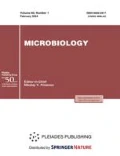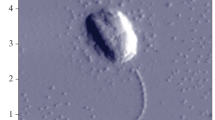Abstract
New strains of Beijerinckia mobilis and Clostridium sp. isolated from the pea rhizosphere were studied with respect to their promoting effect on the growth and development of some agricultural crops. Seed soaking in bacterial suspensions followed by the soil application of the suspensions or their application by means of foliar spraying was found to be the most efficient method of bacterization. The application of B. mobilis andClostridium sp. cultures in combination with mineral fertilizers increased the crop production by 1.5–2.5 times. The study of the population dynamics of B. mobilis by the method of genetic marking showed that this bacterium quickly colonized the rhizoplane of plants and, therefore, had characteristics of an r-strategist. At the same time, Clostridiumsp. was closer to K-strategists, since this bacterium slowly colonized the econiches studied. The introduction of the bacteria into soil did not affect the indigenous soil bacterial complex. The presence of Clostridium sp. slowed down the colonization of roots by the fungal mycelium. The possible mechanisms of the plant growth–promoting activity of B. mobilisand Clostridiumsp. are discussed.
Similar content being viewed by others
REFERENCES
Rovira, A.D., Manipulation of the Rhizosphere Microflora to Increase Plant Production, Reviews of Rural Science 6: Biotechnology and Recombinant DNA Technology in the Animal Production Industries, Leng, R.A. et al., Eds., University New England, 1985, pp. 185–197.
Lynch, J.D., The Rhizosphere, New York: Wiley, 1990.
Kloepper, J.W., Lifshitz, R., and Zablotowicz, R.M., Free-living Bacterial Inocula for Enhancing Crop Productivity, Trends Biotechnol., 1989, vol. 7, pp. 39–43.
Glick, B.R., The Enhancement of Plant Growth by Free-living Bacteria, Can. J. Microbiol., 1995, vol. 41, pp. 109–117.
Patten, C.L. and Glick, B.R., Bacterial Biosynthesis of Indole-3-Acetic Acid, Can. J. Microbiol., 1996, vol. 42, pp. 207–220.
Krasil'nikov, N.A., Mikroorganizmy pochvy i vysshie rasteniya (Soil Microorganisms and Higher Plants), Moscow: Akad. Nauk SSSR, 1958.
Wang, Y.Y., Brown, H.N., Crowley, D.E., and Szaniszlo, P.J., Evidence for Direct Utilization of Siderophore, Ferioxamine B, in Axenically Grown Cucumber, Plant Cell Environ., 1993, vol. 16, pp. 579–585.
Glick, B.R., Penrose, D.M., and Li, J., A Model for the Lowering of Plant Ethylene Concentrations by Plant Growth-promoting Bacteria, J. Theor. Biol., 1998, vol. 190, pp. 63–68.
Brown, M.E., Seed and Root Bacterization, Annu. Rev. Phytopathol., 1974, vol. 12, pp. 181–197.
Davison, J., Plant Beneficial Bacteria, Bio/Technology, 1988, vol. 6, pp. 282–286.
Bashan, Y. and Levanony, H., Current Status of Azospirillum Inoculation Technology: Azospirillum as a Challenge for Agriculture, Can. J. Microbiol., 1990, vol. 36, pp. 591–608.
Glick, B.R. and Bashan, Y., Genetic Manipulation of Plant Growth-promoting Bacteria to Enhance Biocontrol of Phytopathogens, Biotechnol. Adv., 1997, vol. 15, no. 2, pp. 353–378.
Timmusk, S., Nicander, B., Granhall, U., and Tillberg, E., Cytokinin Production by Paenibacillus polymyxa, Soil Biol. Biochem., 1999, vol. 31, pp. 1847–1852.
Ryder, M.H., Yan, Z., Terrace, T.E., Rovira, A.D., Tang, W., and Correl, R., Use of Strains of Bacillus Isolated in China to Suppress Take-All and Rhizoctonia Root Rot and Promote Seedling Growth of Glasshouse Wheat in Australian Soils, Soil Biol. Biochem., 1999, vol. 31, pp. 19–29.
Bergey's Manual of Systematic Bacteriology, 9th ed., Holt, J.G. et al., Eds., Baltimore: Williams & Wilkins, 1994.
Drahos, D.L., Methods for Detection, Identification and Enumeration of Microbes, Microbial Ecology of Leaves, Andrews, J.H. and Hirano, S.S., Eds., New York: Springer-Verlag, 1992, pp. 135–157.
Metody pochvennoi mikrobiologii i biokhimii (Methods of Soil Microbiology and Biochemistry), Moscow: Mosk. Gos. Univ., 1991.
Kirillova, N.P., Dynamics of Microbial Populations in Model Soil-Plant Systems, Cand. Sci. (Biol.) Dissertation, Moscow: Moscow State University, 1983.
Mahaffe, W.F. and Kloepper, J.W., Temporal Change in the Bacterial Communities of Soil, Rhizosphere and Endorhiza Associated with Field-grown Cucumber (Cucumis sativus L.), Microb. Ecol., 1997, vol. 34, pp. 210–223.
Triger, E.G., Polyanskaya, L.M., and Kozhevin, P.A., Microbial Interactions in Soil with Reference to Some Populations of Streptomycetes and Bacteria, Mikrobiologiya, 1990, vol. 59, no. 4, pp. 688–694.
Author information
Authors and Affiliations
Rights and permissions
About this article
Cite this article
Polyanskaya, L.M., Vedina, O.T., Lysak, L.V. et al. The Growth-promoting Effect of Beijerinckia mobilis and Clostridium sp. Cultures on Some Agricultural Crops. Microbiology 71, 109–115 (2002). https://doi.org/10.1023/A:1017914803544
Issue Date:
DOI: https://doi.org/10.1023/A:1017914803544




